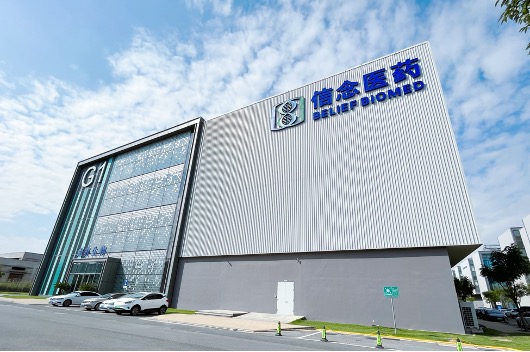China’s first AAV gene therapy breaks through
April 17, 2025
Source: drugdu
 639
639
 Recently, China's gene therapy field has ushered in a historic breakthrough - Xinxin Pharmaceutical's AAV gene therapy Xinjiuning® (BBM-H901 injection, generic name: Bopidarcoside injection) was approved for marketing, becoming the first approved gene therapy drug for hemophilia B in China.
Recently, China's gene therapy field has ushered in a historic breakthrough - Xinxin Pharmaceutical's AAV gene therapy Xinjiuning® (BBM-H901 injection, generic name: Bopidarcoside injection) was approved for marketing, becoming the first approved gene therapy drug for hemophilia B in China.
The code to break the game
The breakthrough of BBM-H901 is not only reflected in the innovation of the technical path, but also in the overall leap in its clinical value. Through precise gene delivery and long-term expression mechanism, the drug breaks the limitations of traditional therapies and opens a new era in the treatment of hemophilia.
From the perspective of annualized bleeding rate, the annualized bleeding rate of patients under traditional treatment is usually high. The ABR determined for the domestic preventive treatment population is about 5.0, while the average ABR of subjects after treatment with BBM-H901 injection is only 0.6 (95% Cl: 0.18-1.99). This means that the bleeding risk of patients receiving BBM-H901 treatment is greatly reduced, which can effectively reduce serious complications such as joint damage and disability caused by bleeding, and greatly improve the quality of life of patients.
BBM-H901 also performed well in enhancing FIX activity. On the third day after infusion, the average FIX activity had rapidly risen to 49.70 IU/dL (SynthASil, phase I method); on the 52nd week after infusion, the average FIX activity reached 55.08 IU/dL (SD35.93) (SynthASil, phase I method). However, traditional therapies often find it difficult to achieve such an ideal and lasting level of FIX activity and are unable to fundamentally solve the problem of coagulation factor deficiency in patients. These significant data advantages fully demonstrate the great potential and breakthrough efficacy of BBM-H901 in the treatment of hemophilia B.
It is worth mentioning that the cooperation between Faith Pharmaceuticals and Takeda is a key step in its commercialization process and has far-reaching strategic significance. As a world-renowned multinational pharmaceutical company, Takeda has rich commercialization experience and extensive market channels in the field of rare diseases. Through cooperation with Takeda, Faith Pharmaceuticals can use its mature sales network and marketing capabilities to quickly promote BBM-H901 to the Chinese mainland, Hong Kong, China and Macau markets, so that more hemophilia B patients can obtain this innovative treatment plan in a timely manner.
Genetic blueprint
It is understood that Xinxin Pharmaceuticals has built a multi-level pipeline layout covering hemophilia, neurological diseases and rare diseases with the core strategy of "focusing on single-gene genetic diseases and tackling major unmet clinical needs".
For hemophilia A and B, Xinxin Pharmaceuticals has deployed two products, BBM-H803 and BBM-H901, respectively. Among them, BBM-H803 is used to treat hemophilia A. It uses an engineered capsid with independent intellectual property rights, has low immunogenicity, high liver delivery efficiency, and the clinical dose is lower than similar AAV gene therapy products that have been marketed abroad. It is expected to be safer. In December 2022, the product was recognized as an orphan drug by the FDA, and in July 2023, it was approved for clinical trials by NMPA. Its registration clinical research has been successfully carried out.
BBM-H901 is a gene therapy drug for hemophilia B. It introduces the human coagulation factor IX (FIX) gene into the patient's body through intravenous administration for continuous expression, so as to improve and maintain the level of coagulation factors in the patient's body for a long time. In July 2024, the new drug application for BBM-H901 injection was officially accepted by NMPA and included in the priority review and approval process. It was approved for marketing in April 2025, becoming the first AAV gene therapy drug approved for marketing in China.
In the field of rare diseases, Faith Pharmaceuticals' BBM-D101 injection focuses on Duchenne muscular dystrophy (DMD). BBM-D101 injection uses an engineered, highly efficient muscle-targeted AAV as a vector to deliver the optimized gene expression cassette to muscles throughout the body in order to achieve a "single-dose, long-term effective" therapeutic effect. In July 2024, its investigator-initiated clinical study (IIT) was launched; in November of the same year, BBM-D101 obtained orphan drug designation and pediatric rare disease qualification from the U.S. FDA, and obtained FDA clinical trial application approval in January 2025.
Entering the field of neurological diseases, Xinxin Pharmaceuticals launched BBM-P002 injection, which aims to overcome the major problem of Parkinson's disease. BBM-P002 injection uses adeno-associated virus (AAV) as a vector, and delivers therapeutic genes to the patient's brain through brain stereotactic injection technology, promoting dopamine synthesis and secretion, and preventing disease progression, in order to achieve the therapeutic effect of "single administration, long-term effectiveness".
Competitive product suppression
In the global gene therapy race, international giants have already made their plans and the competition is fierce.
SPK-9001, a gene therapy for hemophilia B developed by Pfizer and Spark, has attracted much attention. SPK-9001 utilizes a novel bioengineered adeno-associated virus (AAV) capsid that expresses codon-optimized, highly active human coagulation factor IX. In related trials, it demonstrated significant therapeutic effects, with the activity of coagulation factor IX reaching a sustained and consistent level, the annualized bleeding rate (ABR) reduced by 96%, and the annualized infusion rate (AIR) reduced by 99%, providing new treatment options for patients with hemophilia B and posing a strong competition to Faith Pharmaceuticals' BBM-H901.
DTX301, jointly developed by Bayer and Ultragenyx, is an AAV8 gene therapy for the treatment of ornithine transcarbamylase deficiency (OTC). The first patient in its third phase was enrolled in February 2023, and all patients were enrolled in the first half of 2024. OTC is a rare inherited metabolic disease with limited treatment options. If DTX301 is successfully developed, it will occupy an important position in this field. With the strong R&D strength and resources of Bayer and Ultragenyx, it is expected to quickly promote the product to market and seize market share.
Domestic companies are also unwilling to lag behind in the research and development of AAV therapies. Companies such as Jinlan Gene and Zhishan Weixin have actively laid out their plans, forming a trend of catching up with Xinxin Pharmaceuticals. Jinlan Gene has achieved fruitful results in the field of gene therapy. Its independently developed GC310 adeno-associated virus injection has been approved for the treatment of hepatolenticular degeneration. Hepatolenticular degeneration is an autosomal recessive genetic disease caused by mutations in the ATP7B gene. The current standard treatment regimen requires patients to undergo long-term or even lifelong frequent drug interventions, and cannot completely restore the normal metabolic balance of copper ions in tissue cells. Through a single treatment, GC310 injection enables the target tissue to express the biologically functional miniATP7B copper ion transporter, restore the copper ion metabolism capacity and increase the level of ceruloplasmin, which is expected to fundamentally improve the condition. In addition, Jinlan Gene's GC101 adeno-associated virus injection has also been approved for clinical use for spinal muscular atrophy (SMA) type 1. It delivers and supplements SMN protein directly to the central nervous system through intrathecal administration, improving the respiratory function and motor ability of SMA patients. It focuses on multiple hot targets and demonstrates strong R&D capabilities.
Zhishan Weixin is also deeply exploring the field of AAV therapy. Its core R&D pipeline ZS801 injection is an AAV gene therapy drug suitable for the control and prevention of bleeding in male patients with severe and moderate to severe hemophilia B aged 18 and above. The design of ZS801 uses the core sequence and efficient gene expression cassette with completely independent intellectual property rights of Zhishan Weixin. The core sequence is an original drug target independently developed by Zhishan Weixin and well-known domestic medical institutions. At present, the product has been approved for clinical trials, and the research is progressing in an orderly manner. It is expected to get a share of the hemophilia B treatment market, intensifying the competition for the same target.
The launch of BBM-H901 marks a qualitative change in China's gene therapy from laboratory to clinical application. With its breakthrough in hemophilia B, Faith Pharmaceuticals not only brings hope to patients, but also lays the fuse for Parkinson's disease, Duchenne muscular dystrophy and other fields. However, with global giants surrounding and domestic competitors chasing, this gene therapy marathon is far from the end.
https://news.yaozh.com/archive/45301.html
By editorRead more on
- Subsidiary Signs Exclusive Licensing Agreement for GenSci098 Injection Project December 17, 2025
- Kangfeng Biotechnology’s Anti-Gastroesophageal Reflux System Receives Approval from the Drug Administration December 17, 2025
- Cell Metabolism | Efficacy of Akkermansia muciniphila Supplementation in Overweight/Obese Patients with Type 2 Diabetes December 17, 2025
- Major Breakthrough! China’s First Injectable Silk Fibroin Gel Enters Clinical Trials December 17, 2025
- Can AOC become the “next stop” for oligonucleotide therapy? December 17, 2025
your submission has already been received.
OK
Subscribe
Please enter a valid Email address!
Submit
The most relevant industry news & insight will be sent to you every two weeks.



